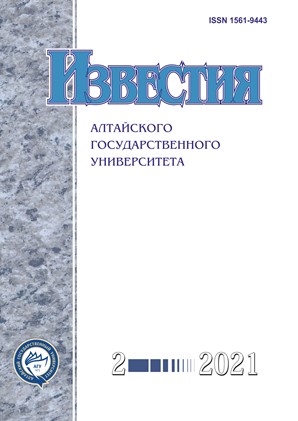The Health Care System of the Semipalatinsk Region of the Steppe Territory: Stages of Formation (60s of the 19th Century — the Beginning of the 20th Century)
УДК 94(574) + 61(574) ББК 63.3(5Каз)6 + 5
Abstract
On the basis of different sources, mainly annual regional statistical surveys, the stages of the formation of the health care system of the Semipalatinsk region of the Steppe Governor General are revealed. At the first stage, the end of the 60s — 80s of the 19th century, the accession of the Steppe Territory to the Russian Empire was completed. The integrating policy of this ethnoregion into the political-legal and socio-economic space of the empire was initiated. In the social sphere, it led to the creation of a health system. The procesas had a number of specific features due to the absence of zemstvos and zemstvo medicine and the predominance of Kazakh nomads in the ethnosocial structure of the region. Therefore, in contrast to the central regions of Russia, the development of the health care system in the Steppe Territory was dealt with by the provincial and regional administrations. The second stage (the end of the 80s 19th century — 1917) is associated with the beginning of the mass migration of peasant migrants from the European part of Russia to the Steppe Territory. This stage is characterized by the expansion of the network of regional and county medical institutions, the improvement of their material and technical base, the expansion of the specialization of practicing doctors, and the solution of the personnel problem.
Also, at that stage, the system of management of medical institutions was improved and government organizations, for example, the Resettlement Department, were involved in solving problems related to health care services for the p opulation. In general, statistics show that by 1917 the quality of health care services and the percentage of population involvement remained at a low level.
Downloads
Metrics
References
Лысенко Ю.А., Анисимова И.В., Тарасова Е.В., Стурова М.В. Традиционное казахское общество в национальной политике Российской империи: концептуальные основы и механизмы реализации (XIX — начало ХХ в.). Барнаул, 2014.
Лысенко Ю.А., Куликова М.В. Система местного самоуправления в казахской степи: идеология реформ и проблемы реализации (конец XVIII — середина XIX в.) // Известия Алтайского гос. ун-та. 2013. №4/1 (80).
Немцов С.Б. Врачебные и фельдшерские пункты Переселенческой организации Акмолинского района и заболеваемость населения в районе пунктов по карточной регистрации за 1906-1910 гг. Омск, 1911.
Ядринцев Н.М. Народно-медицинская помощь и санитарные отряды в Сибири // Русские ведомости. 1892. 11 июля.
Обозненко П.Е. Очерки санитарного состояния селений переселенцев-новоселов Омского уезда Акмолинской области. СПб., 1898.
Ремезов А.И. Очерк санитарного состояния Западной Сибири. Омск, 1880.
Капустин М.Я. Основные вопросы Земской медицины. СПб., 1889.
Жбанков Д.Н. Итоги Земской медицины // Врач. 1899. №19.
Забулдовский П.Е. История отечественной медицины. М., 1960.
Страшун И.Д. Очерки истории русской общественной медицины. М., 1965.
Бородулин Ф.Р. История медицины. М., 1961.
Палкин Б.Н. Очерки истории медицины и здравоохранения Западной Сибири и Казахстана в период присоединения к России (1716-1868). Новосибирск, 1967.
Самарин Р.И. Очерки истории здравоохранения Казахстана. Алма-Ата, 1958.
Рубаева Э.М. Становление и развитие системы здравоохранения в Тверской области: вторая половина XIX — нач. XX в. : дис. ... канд. ист. наук. Владикавказ, 2011.
Сосновская И.А. Развитие системы здравоохранения в Орловской губернии во второй половине XIX — начале XX в. : дис. . канд. ист. наук. Брянск, 2013.
Ахмадов Т.З. Становление и развитие врачебно-санитарного дела на Северо-Восточном Кавказе (XIX в. — 1940 г.) : дис. ... канд. ист. наук. М., 2014.
Полякова Е.П. Становление системы здравоохранения в Уфимской губернии во второй половине XIX в. — начале XX в. // Приволжский научный вестник. №4. Нижний Новгород, 2017.
Скопа В.А. Организация и основные направления работы переселенческого управления в Семипалатинской области в конце XIX — начале XX вв. // Исторические, философские, политические и юридические науки, культурология и искусствоведение. Вопросы теории и практики. Тамбов, 2017. №10 (84), ч. 1.
Устав врачебный // Свод законов Российской империи. СПб., 1857. Т. 13.
Моллесон И.И. Земская медицина. Казань, 1871.
Усоф Ф. Статистические описания Сибирского казачьего войска. СПб., 1879.
Колупаев Д.В. Здравоохранение в поселениях сибирского казачества во второй половине XIX в. // Известия Алтайского гос. ун-та. 2008. № 4-5 (60).
Обзор Семипалатинской области за 1880 год. Семипалатинск, 1881.
Обзор Семипалатинской области за 1887 год. Семипалатинск, 1888.
Обзор Семипалатинской области за 1890 год. Семипалатинск, 1891.
Обзор Семипалатинской области за 1895 год. Семипалатинск, 1896.
Обзор Семипалатинской области за 1902 год. Семипалатинск, 1903.
Российский государственный исторический архив. Ф. 391. Оп. 3. Д. 95.
Обзор Семипалатинской области за 1906 год. Семипалатинск, 1907.
Izvestiya of Altai State University is a golden publisher, as we allow self-archiving, but most importantly we are fully transparent about your rights.
Authors may present and discuss their findings ahead of publication: at biological or scientific conferences, on preprint servers, in public databases, and in blogs, wikis, tweets, and other informal communication channels.
Izvestiya of Altai State University allows authors to deposit manuscripts (currently under review or those for intended submission to Izvestiya of Altai State University) in non-commercial, pre-print servers such as ArXiv.
Authors who publish with this journal agree to the following terms:
- Authors retain copyright and grant the journal right of first publication with the work simultaneously licensed under a Creative Commons Attribution License (CC BY 4.0) that allows others to share the work with an acknowledgement of the work's authorship and initial publication in this journal.
- Authors are able to enter into separate, additional contractual arrangements for the non-exclusive distribution of the journal's published version of the work (e.g., post it to an institutional repository or publish it in a book), with an acknowledgement of its initial publication in this journal.
- Authors are permitted and encouraged to post their work online (e.g., in institutional repositories or on their website) prior to and during the submission process, as it can lead to productive exchanges, as well as earlier and greater citation of published work (See The Effect of Open Access).








